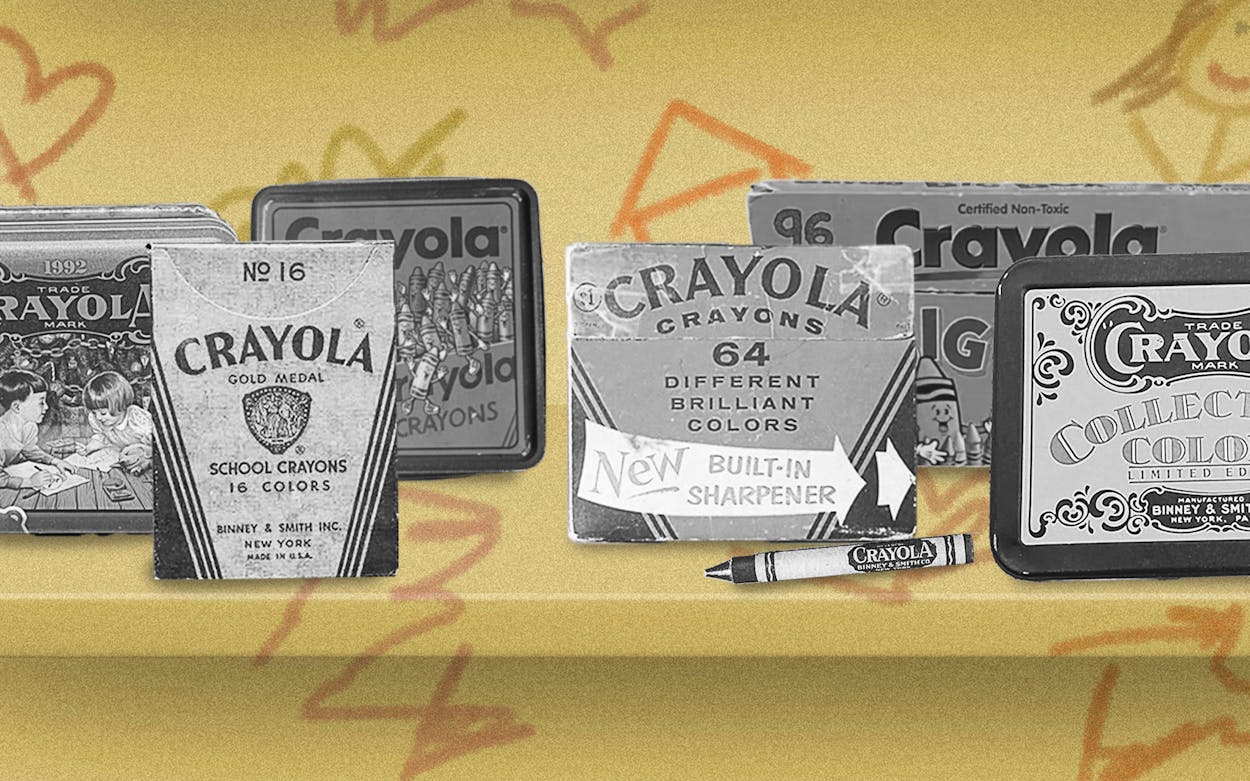The collection
49,000 crayons.
Years in the making
Twenty.
Most rare item
A single Torch Red crayon. The color, a true primary red, was only available for one year before its name was changed.
There are few things more wholesome than a crayon, a children’s tool used to make imaginative creatures and colors manifest on the page. The smell of the art utensil, which is to say the smell of wax, can snap a tax-paying adult’s brain back to a freer, simpler time.
The moment you cross the threshold into Richard and Ginger Gwyn’s home in Kerrville, about an hour northwest of San Antonio, you’re hit with the scent of an elementary school classroom, or of a young person’s playroom, or of the unbridled creativity of childhood.
“It’s wax to the max,” Richard says by way of greeting.
“To the max” is not hyperbole. Richard’s collection of 49,000 Crayola crayons spans an entryway, a den, and a connecting room, and is distributed among 863 crayon boxes arranged within a dozen or so display hutches and old-timey soda boxes. (Richard jokes that he now also collects storage containers.) Around the hutches hang memorabilia dedicated to the Pennsylvania-based company, including a Crayola clock with two crayons as hands, Crayola bandaids, a crayon-shaped pillow, crayon-shaped string lights, and crayon-like fan pulls, as well as a secondary collection of Crayola Christmas ornaments.
The colorful behemoth was born twenty years ago when Richard, then living in Houston, came across three nineties-era Crayola tins. Something about the void of those empty boxes inspired him. He felt compelled to find an original version of the tin that still contained the crayons. He eventually did—and then some.
Since 2003, Richard has slowly grown his collection via thrift stores, estate sales, the internet, and the generosity of loved ones and strangers who learn about his passion. The assemblage is arranged roughly by age and type. The oldest boxes, dating back to 1917 and 1920, then on through the decades, reside in their own hutch. Another cabinet is dedicated to international boxes, featuring packs from Japan, Germany, and Israel, as well as crayons from Crayola’s flesh-themed “Colors of the World” line. Since the couple moved to Kerrville five years ago, the collection has nearly doubled, filling a second room in their new home.
Richard doesn’t use any of the boxed or displayed goods on his many crayon-based artworks, which depict mostly birds and landscapes. His affection for the artistic medium is not a random fancy: he has used the wax sticks to create art throughout his entire life, preferring the challenge of crayon drawing over the more forgiving and blendable paint. (Crayons are also less messy, and cheaper, on the whole.) Unlike the flat, two-dimensional shapes in a children’s coloring book, Richard’s works create the appearance of shadows through built-up layers of crayon and blended colors. During summers at the local Museum of Western Art, he and Ginger teach kids his technique; in the offseason he hones his skill in a dog-themed coloring book.
Crayons, like any collectible, also come with stories. Richard and Ginger cherish what they’ve gathered over the years. One box, found in the basement of an estate sale, features a tiny bullet hole—made by a .22, Richard’s ballistic expert says—that punctured the side of a 24-pack and exploded through the front. In another, the pair discovered a note in a child’s handwriting detailing a vague existential crisis, tucked into the box as if hidden.
Meanwhile, Richard has also become an expert on crayons. Torch Red, he tells me, is so rare that he owns only one single stick of the color before its name was changed to Scarlet in 1998. Wax is the eighteenth most-recognizable scent, he says. The squiggle pattern printed on all crayons is copyrighted by Crayola. And, his favorite tidbit, the crayon made its debut in 1903, the same year that Ford was founded and that the Wright brothers first flew a plane.
In the past 120 years, look how much cars and planes have evolved, says Richard. But behold the humble crayon, he seems to say, unchanged after all that time—perfect in its very first iteration.
- More About:
- Style & Design
- Kerrville








